The Intel Kaby Lake-X i7 7740X and i5 7640X Review: The New Single-Threaded Champion, OC to 5GHz
by Ian Cutress on July 24, 2017 8:30 AM EST- Posted in
- CPUs
- Intel
- Kaby Lake
- X299
- Basin Falls
- Kaby Lake-X
- i7-7740X
- i5-7640X
Benchmarking Performance: CPU Rendering Tests
Rendering tests are a long-time favorite of reviewers and benchmarkers, as the code used by rendering packages is usually highly optimized to squeeze every little bit of performance out. Sometimes rendering programs end up being heavily memory dependent as well - when you have that many threads flying about with a ton of data, having low latency memory can be key to everything. Here we take a few of the usual rendering packages under Windows 10, as well as a few new interesting benchmarks.
All of our benchmark results can also be found in our benchmark engine, Bench.
Corona 1.3: link
Corona is a standalone package designed to assist software like 3ds Max and Maya with photorealism via ray tracing. It's simple - shoot rays, get pixels. OK, it's more complicated than that, but the benchmark renders a fixed scene six times and offers results in terms of time and rays per second. The official benchmark tables list user submitted results in terms of time, however I feel rays per second is a better metric (in general, scores where higher is better seem to be easier to explain anyway). Corona likes to pile on the threads, so the results end up being very staggered based on thread count.
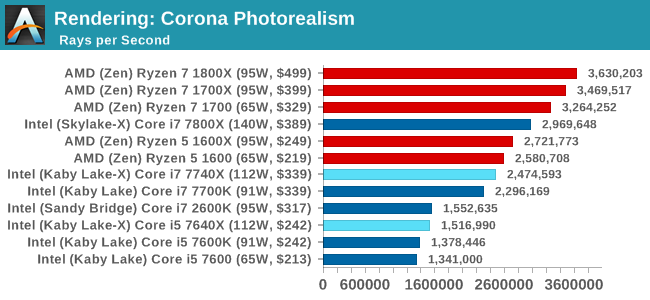
More threads win the day, although the Core i7 does knock at the door of the Ryzen 5 (presumably with $110 in hand as well). It is worth noting that the Core i5-7640X and the older Core i7-2600K are on equal terms.
Blender 2.78: link
For a render that has been around for what seems like ages, Blender is still a highly popular tool. We managed to wrap up a standard workload into the February 5 nightly build of Blender and measure the time it takes to render the first frame of the scene. Being one of the bigger open source tools out there, it means both AMD and Intel work actively to help improve the codebase, for better or for worse on their own/each other's microarchitecture.
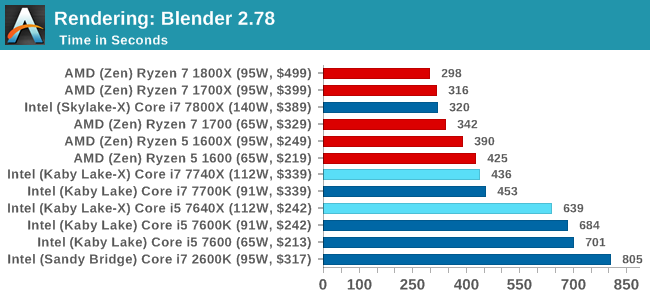
Similar to Corona, more threads means a faster time.
LuxMark v3.1: Link
As a synthetic, LuxMark might come across as somewhat arbitrary as a renderer, given that it's mainly used to test GPUs, but it does offer both an OpenCL and a standard C++ mode. In this instance, aside from seeing the comparison in each coding mode for cores and IPC, we also get to see the difference in performance moving from a C++ based code-stack to an OpenCL one with a CPU as the main host.
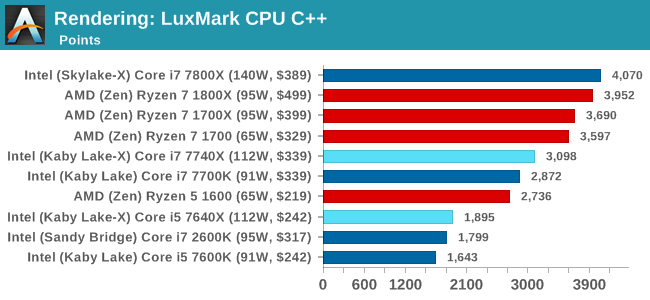
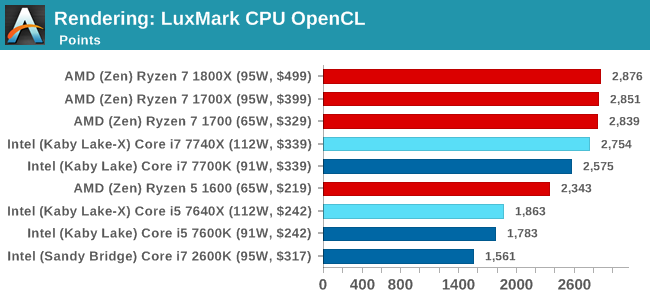
Luxmark is more thread and cache dependent, and so the Core i7 nips at the heels of the AMD parts with double the threads. The Core i5 sits behind the the Ryzen 5 parts though, due to the 1:3 thread difference.
POV-Ray 3.7.1b4: link
Another regular benchmark in most suites, POV-Ray is another ray-tracer but has been around for many years. It just so happens that during the run up to AMD's Ryzen launch, the code base started to get active again with developers making changes to the code and pushing out updates. Our version and benchmarking started just before that was happening, but given time we will see where the POV-Ray code ends up and adjust in due course.
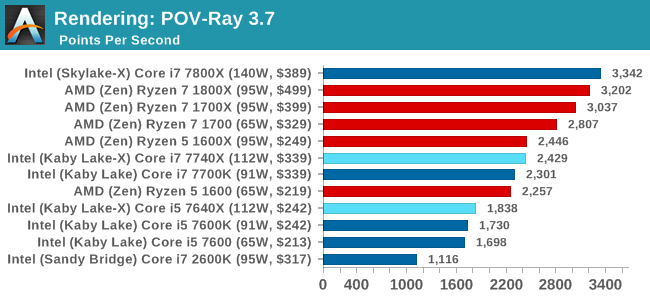
Mirror Mirror on the wall...
Cinebench R15: link
The latest version of CineBench has also become one of those 'used everywhere' benchmarks, particularly as an indicator of single thread performance. High IPC and high frequency gives performance in ST, whereas having good scaling and many cores is where the MT test wins out.
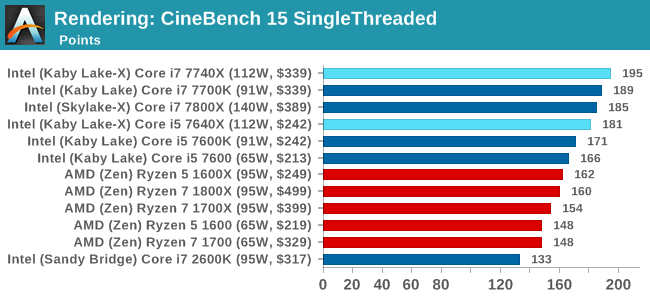
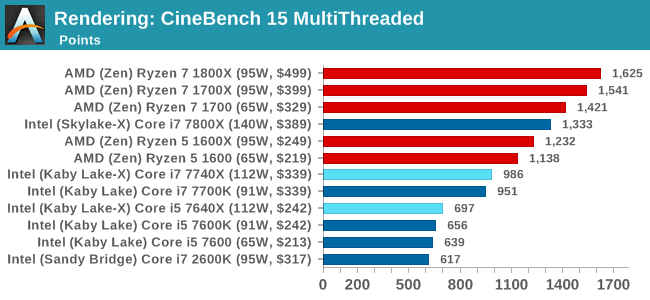
CineBench gives us singlethreaded numbers, and it is clear who rules the roost, almost scoring 200. The Core i7-2600K, due to its lack of instruction support, sits in the corner.










176 Comments
View All Comments
Gothmoth - Tuesday, July 25, 2017 - link
so why not test at 640x480... shifts the bottleneck even more to the cpu... you are kidding yourself.silverblue - Tuesday, July 25, 2017 - link
Not really. If the GPU becomes the bottleneck at or around 1440p, and as such the CPU is the limiting factor below that, why go so far down when practically nobody games below 1080p anymore?Zaxx420 - Monday, July 24, 2017 - link
"Over the last few generations, Intel has increased IPC by 3-10% each generation, making a 30-45% increase since 2010 and Sandy Bridge..."I have an old Sandy i5 2500K on an Asus Z68 that can do 5GHz all day on water and 4.8 on air. I know it's ancient IP...but I wonder if it could hold it's own vs a stock clocked Skylake i5? hmmmm...
hbsource - Tuesday, July 25, 2017 - link
Great review. Thanks.I think I've picked the best nit yet: On the Civ 6 page, you inferred that Leonard Nimoy did the voiceover on Civ 5 when he actually did it on Civ 4.
gammaray - Tuesday, July 25, 2017 - link
it's kind of ridiculous to see the Sandy bridge chip beating new cpus at 4k gaming...Zaxx420 - Tuesday, July 25, 2017 - link
Kinda makes me grin...I have an old Sandy i5 2500K on an Asus Z68 that can do 5GHz all day on water and 4.8 on air. I know it's ancient IP...but I wonder if it could hold it's own vs a stock clocked Skylake i5? hmmmm...
Mugur - Tuesday, July 25, 2017 - link
Much ado about nothing. So the best case for 7740 is Office applications or opening PDF files? The author seems to have lost the sight of the forest because of the trees.Some benchmarks are odd, some are useless in the context. I watched the YouTube version of this: https://www.techspot.com/review/1442-intel-kaby-la... and it looked like a more realistic approach for a 7740k review.
Gothmoth - Tuesday, July 25, 2017 - link
well i guess intel is putting more advertising money on anandtech.otherwise i cant´t explain how an overpriced product with heat problems and artificial crippled pci lanes on an enthusiast platform(!) can get so much praise without much criticism.
jabber - Tuesday, July 25, 2017 - link
I miss the days when you saw a new bunch of CPUs come out and the reviews showed that there was a really good case for upgrading if you could afford to. You know a CPU upgrade once or twice a year. Now I upgrade (maybe) once every 6-7 years. Sure it's better but not so much fun.Dragonstongue - Tuesday, July 25, 2017 - link
Intel wins for the IO and chipset, offering 24 PCIe 3.0 lanes for USB 3.1/SATA/Ethernet/storage, while AMD is limited on that front, having 8 PCIe 2.0 from the chipset.Funny that is, seeing as AM4 has 16 pci-e lanes available to it unless when go down the totem pole those lanes get segregated differently , even going from the above table Intel is offering 16 for x299not 24 as you put directly into words, so who wins in IO, no one, they both offer 16 lanes. Now if you are comparing via price, x299 is obviously a premium product, at least compare to current AM4 premium end which is x370 chipset, pretty even footing on the motherboards when compared similar "specs" comparing the best AMD will offer in the form of x399, it makes the best "specs" of x299 laughable.
AMD seems to NOT be shortchanging pci-e lanes, DRAM ability (or speed) functional, proper thermal interface used etc etc.
Your $ by all means, but seriously folks need to take blinders off, how much raw power is this "95w TDP" processors using when ramped to 5+Ghz, sure in theory it will be the fastest for per core performance, but how long will the cpu last running at that level, how much extra power will be consumed, what price of an acceptable cooler is needed to maintain it within thermal spec and so forth.
Interesting read, but much seems out of context to me. May not like it, but AMD has given a far better selection of product range this year for cpu/motherboard chipsets, more core, more threads, lots of IO connectivity options, fair pricing overall (the $ value in Canada greed of merchants does not count as a fault against AMD)
Am done.